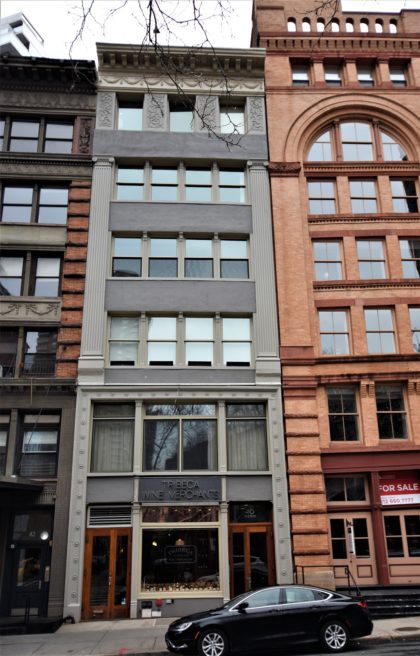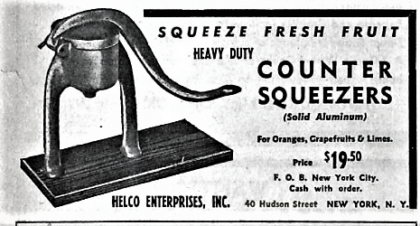The History of 40 Hudson
 Tom Miller, who writes about the history of Manhattan buildings at Daytonian in Manhattan, has allowed Tribeca Citizen to create a database of his Tribeca posts. If you enjoy these, and you will, then you should definitely check out his website, which also has write-ups about buildings all over the island. And don’t miss his book, Seeking New York: The Stories Behind the Historic Architecture of Manhattan—One Building at a Time.
Tom Miller, who writes about the history of Manhattan buildings at Daytonian in Manhattan, has allowed Tribeca Citizen to create a database of his Tribeca posts. If you enjoy these, and you will, then you should definitely check out his website, which also has write-ups about buildings all over the island. And don’t miss his book, Seeking New York: The Stories Behind the Historic Architecture of Manhattan—One Building at a Time.
··································
 Edward E. Ashley was a one-man show as the turn of the last century approached. A trained architect, he was also a builder and acted as his own real estate operator as well. Although he most often constructed apartment buildings, on March 6, 1897, the Real Estate Record & Guide reported that he had filed plans for a 25-foot wide “brick and store store and lofts” building. The six-story structure would cost $20,000 to erect; about $597,000 today.
Edward E. Ashley was a one-man show as the turn of the last century approached. A trained architect, he was also a builder and acted as his own real estate operator as well. Although he most often constructed apartment buildings, on March 6, 1897, the Real Estate Record & Guide reported that he had filed plans for a 25-foot wide “brick and store store and lofts” building. The six-story structure would cost $20,000 to erect; about $597,000 today.
Completed the following year, Ashley’s loft building rejected showy ornamentation in favor of two three-story fluted pilasters at the mid-section, handsome Renaissance Revival panels at the top floor, and a neo-Classical frieze of swags below the cornice. The two-story cast-iron storefront wore an egg-and-dart lined frame with button-like bosses.
The building became home to the J. T. Huner Co., operated by John T. Huner. A jobber, he represented match manufacturers, like the Modern Match Company and Improved Match Company, both based in Detroit. Not long after moving into the Hudson Street building, Huner found himself up against a formidable adversary—the massive Diamond Match Company.
In 1899 he received a latter from a client, Von Glahn Brothers, dated October 10: “With regret must we inform you that the Diamond Match Company have informed us that if any other matches but their own were handled by us they would cut us off on their goods. You can readily see that in the position in which we are placed it will be impossible for us to do any business with you at present.”
Enraged, Huner went to the press. A New York Times journalist investigated and found Diamond Match Company coolly unapologetic. “Frank B. Clagget, manager of the Diamond Match Company, frankly admitted that the letter in question had been sent to Von Glahn Brothers. He said there was nothing unusual about it,” reported the newspaper on October 26.
It was the first shot in a battle John Huner would fight for years.
But attention briefly turned to a horrifying accident on October 4, 1900. John Anderson worked as a traveling salesman for Huner. The 18-year old lived in a boarding house on tiny James Street near the East River. On warm evenings he often went to the roof, where he would sit on “a stone on the edge of the wall,” as explained by The Times the following day.
Anderson was not the only boarder in the habit of taking the night air on the roof. Another came up to join him that night. “As he turned to speak to the newcomer the stone beneath him loosened and tilted, and he was precipitated over the edge.” Anderson bounced off the roof of an adjoining building, which somewhat broke his fall, before hitting the pavement five floors below. Nevertheless, he was badly mangled. He suffered a broken arm, several broken ribs and numerous other broken bones. His severe scalp wound caused concern that he had also fractured his skull. Still doctors held out hope for “a chance of recovery.”
Earlier that year the ground floor had become home to the R. Lederer bakery.
The animosity between Huner and the Diamond Match Company was in full evidence when Fire Commissioner C. A. Haskell called a meeting of various match company representatives at Fire Headquarters on December 20, 1902. The purpose was to propose regulations on the sale and storage of the “much proscribed parlor match.”
The Evening World reported “the meeting was soon the scene of a wordy battlefield, in which Messrs. J. T. Huner, of the Darling Match Company, and G. H. Hawkins, of the Diamond Match Company, were most conspicuous for their ferocious attacks upon the proposed provisions and upon each other. Each accused the other of violating the agreement regarding the size of the package required, and wound up their hostile demonstrations by shaking their fists in each other’s faces.”
In the first years of the 20th century, the shoe district was overtaking the Hudson Street neighborhood. J. T. Huner was replaced at No. 40 by the Bay State Shoe & Leather Co. around 1905. Edwin Wildes Bigelow was the shoe company’s president. He moved the operation from Ossining, New York after workers went on strike there.
The wealthy manufacturer temporarily lived to at No. 251 W. 72nd Street when he relocated the firm. But he soon moved his family into a mansion on Schermerhorn Street in fashionable Brooklyn Heights. He and his wife, Maud, suffered heartbreak when their 15-year old son, Wildes, died of pneumonia there on January 4, 1907. In reporting on his death, the New-York Tribune mentioned, “The Bigelow family has been prominent in Brooklyn society for several seasons.”
The Bay State Shoe & Leather Co. remained in the building at least through 1918. As mid-century neared, the shoe industry had moved on and No. 40 became home to a hodge-podge of offices and light manufacturing.
By the mid-1940’s, commercial equipment firms operated from the building. Among them were Helco Enterprises, Inc.; the Tropical Fruit Drinks Co., which sold equipment like stainless steel fruit drink dispensers and “two pump” soft drink dispensers; and C & K Equipment Co., another equipment supplier to drink concessionaires.
 A 1945 ad for Helco Enterprises in Billboard magazine.
A 1945 ad for Helco Enterprises in Billboard magazine.
··································
For about three decades, beginning in the mid-1960’s, the Hudson Electric Sales Co. occupied the ground floor. But industrial electric supplies would give way to toys as the Tribeca neighborhood was rediscovered. In May, 1995, Just Jake opened in the street-level shop. In reporting on the innovative store, Delcie Leimbach wrote in The New York Times, “Designed by Dean/Wolf Architects in New York, it is a toy store with a twist: children are welcome to sample most of the items on sale. There are balls to roll around on, materials for art projects, a stage that beckons young puppeteers and a carpeted ‘Book Boat’ that is lined with books.”
Just Jake was still here when the upper floors were converted to residences, one per floor, on 1998. It gave way to a more grown-up store, Tribeca Wine Merchants, around 2004. In 2007, a penthouse, invisible from street level, was added to accommodate a duplex apartment.
Despite the woeful modernization that obliterated the decorative panels between each upper floor, the integrity of Edward E. Ashley’s design is generally intact.
··································
Photo credits from top: Daytonian in Manhattan; Billboard.












